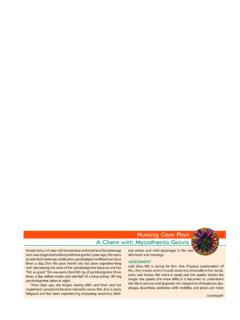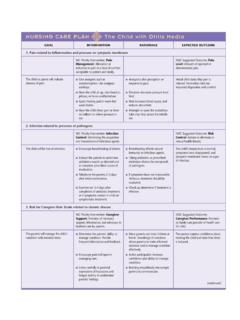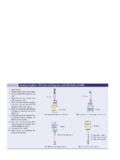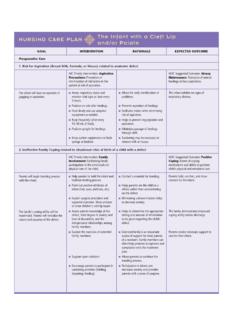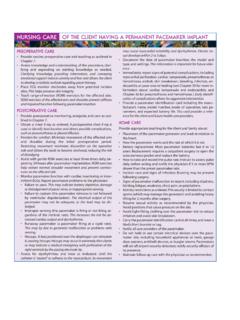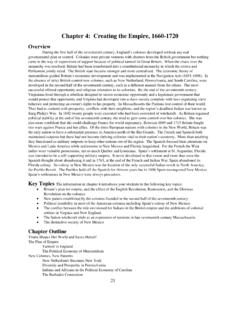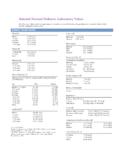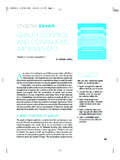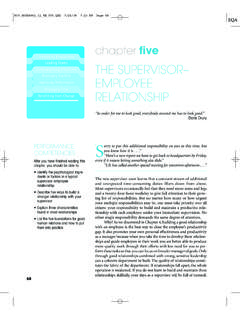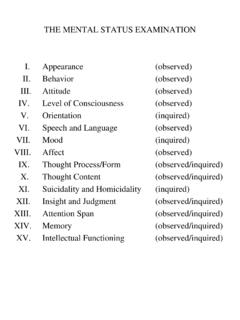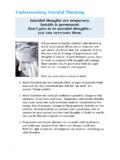Transcription of Mental Disorders TABLE 13.1 Descriptors of Affect
1 298 Unit 3 Mental Disorders100366 CPEd /NJ/CHETAFiP N298C/M/Y/K/PMSDESIGN SERVICES OFwith double depression have more severe symptoms and higherrates of suicide than clients with MDD (Klein, Shankman,Lewinsohn, Rohde, & Seeley, 2004).The medical diagnosis of bipolar disorderis given whena person s mood alternates between the extremes of depressionand elation (mania), with interspersing periods of normalmood. Bipolar I disorderis characterized by the occurrence ofone or more manic episodes and one or more depressiveepisodes. Bipolar II disorderis characterized by one or morehypomanic episodes (less severe) and one or more depressiveepisodes. There is evidence that some individuals experiencea unipolar mania with no depressive episodes.
2 Data suggeststhat unipolar disorder and bipolar disorder are not two sep-arate Disorders but rather the same disorder with fluctuationsin mood (Cassano et al., 2004; Schneck et al., 2004; Solomonet al., 2003).Bipolar disorder is further classified as: Mixed:The person has rapidly alternating moods. Manic:The person is presently in the manic phase. Depressed:The person is in the depressed phase but hasa history of manic cyclingdescribes the course for some people of bipo-lar disorder. It is defined as four or more episodes of illnesswithin a 12-month period. A person with rapid cycling couldbe diagnosed as bipolar I, II, or mixed, manic, or cycling occurs in 10% to 20% of persons with bipolardisorder, with 70% to 90% of rapid cyclers being form of the disorder tends to be more resistant to treat-ment than the non rapid-cycling course (Schneck et al.)
3 , 2004)Cyclothymic disorderis characterized by a mood rangefrom moderate depression to hypomania, which may ormay not include periods of normal mood, lasting at least2 years. Clients with cyclothymic disorder do not experiencethe severe symptoms that qualify for a diagnosis of MDDor bipolar disorder. Figure illustrates our current un-derstanding of mood disorderis diagnosed when clients havesymptoms that appear to be a mixture of schizophreniaand the mood Disorders . The person with schizoaffectivedisorder experiences one or more of the following symp-toms: delusions, hallucinations, disorganized speech, disorganized behavior, or negative symptoms (seechapter 14 for more detailed discussion of these symp-toms).
4 In addition, the person experiences symptoms ofthe mood Disorders : major depressive symptoms, manicsymptoms, or mixed symptoms. Clients often have diffi-culty maintaining job or school functioning, experienceproblems with self-care, are socially isolated, and often suf-fer from suicidal ideation. The age of onset is typically lateadolescence or early the DSM-IV-TR feature for the diagnostic criteriafor major depression and manic of AffectAffectDefinitionBehavioral ExampleAppropriateMood is congruent with the immediate cries when learning of the death of his is not related to the immediate Sue s husband tells her about his terrible pain,Sue begins to laugh out is resistant to sudden changes when there isno provocation in the a party, Dan smiles and laughs at theappropriate social shifts suddenly in a way that cannot beunderstood in the context of the a friendly game of checkers, Dorothy, who hasbeen laughing.
5 Suddenly knocks the board off the tablein anger. She then begins to laugh and wants tocontinue the is one of euphoria not necessarily related tothe immediate bounces around the dayroom, laughing, singing,and telling other clients how wonderful everything is one of despondency not necessarilyrelated to the immediate sits slumped in a chair with a sad facialexpression, teary eyes, and minimal body is appropriate to the situation but out ofproportion to the immediate screams and curses when her child spills a glassof milk on the kitchen is a dulled response to the Tom learns of his full-tuition scholarship, heresponds with only a small are no visible cues to the person s Juanita is told about her best friend s death, shesays Oh and does not give any indication of anemotional Application, Personal Account of Rapid-Cycling Bipolar 6/9/08 10:15 AM Page 298
